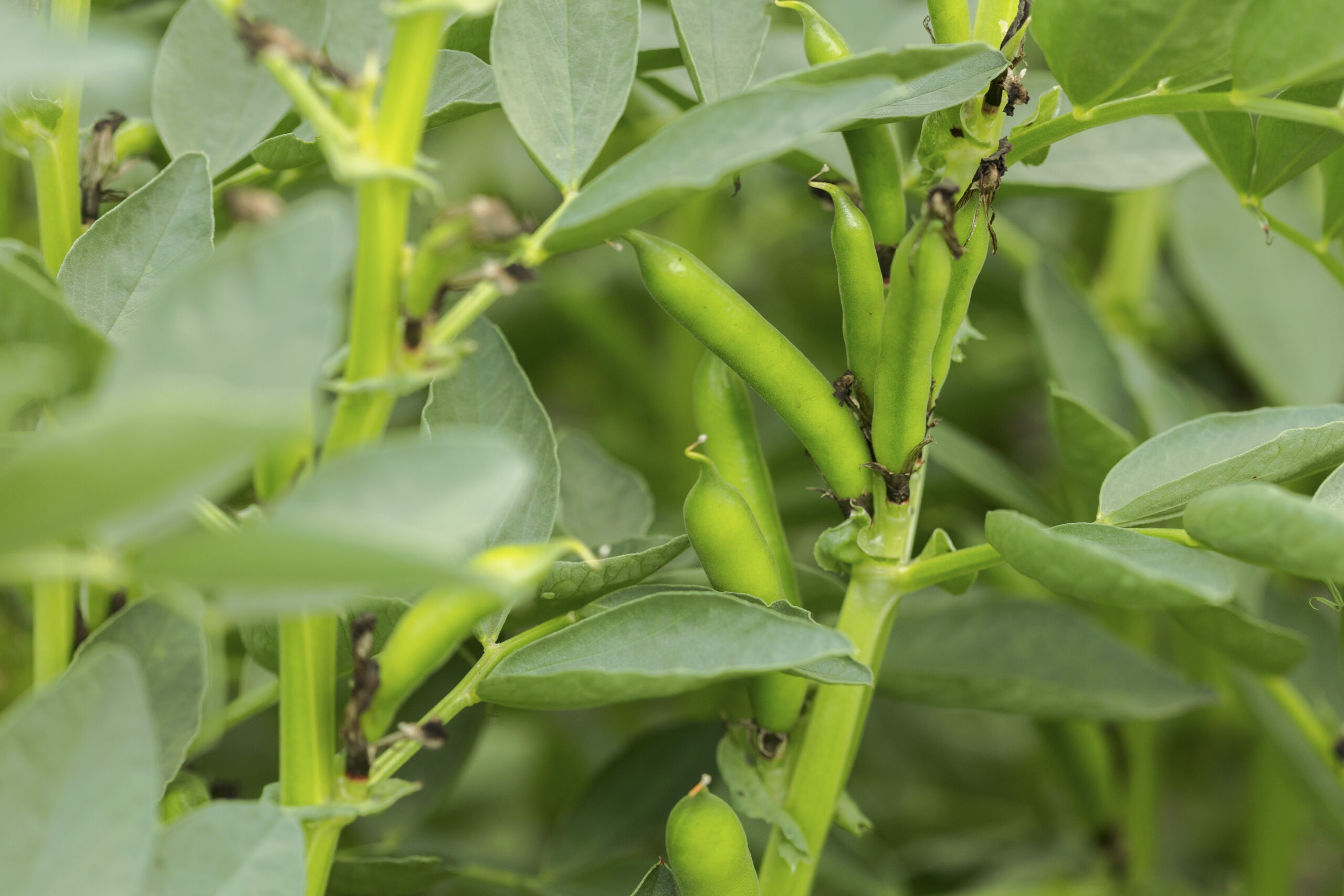Weed Management
Faba beans are a poor competitor, so good weed control is essential and often the most important consideration for profitable faba bean production. It may be beneficial to utilize an integrated weed management strategy, combining both herbicides and cultural control methods.
The major weeds of concern in faba bean crops are Canada thistle and perennial sow thistle. Other significant weeds include cow cockle, round-leaved mallow, bluebur, cleavers, and wild tomato.
Weed Seedling Identification
Good weed management begins with knowing what weeds are present. Perennial weeds are best controlled pre-harvest in the previous crop. Fields should be inspected again before freeze-up, first thing in the spring as this is an ideal time to control winter annuals. The next weed inspection should be just before planting to time pre-seed burn-off. Fields should be inspected again upon crop emergence to establish the frequency and distribution of weed species and to determine appropriate herbicide products for post-emergent weed control.
Herbicide Resistant Weeds
Weed populations contain a great deal of natural variability to survive changing environmental conditions. Herbicides select for individual plants with the ability to survive the herbicide treatment. Surviving plants then contribute to a larger proportion of the weed population. It is important to realize that selection for herbicide-resistant weeds occurs each time an herbicide is applied.
Herbicides have different modes of action. Some modes of action are easy for weeds to develop resistance to as it only requires variation in a few genes (high risk of resistance), while others may require changes in multiple genes (low risk of resistance).
Herbicide-resistant weeds are more likely to occur under the following conditions:
- High weed number
- Too frequent use of a single herbicide group or mode of action
- Not using recommended rates
- Allowing surviving weeds to set seed
Resistance is not reversible. That means stopping the use of the herbicide will not change the frequency of resistance in the weed population. However, research indicates that alternating between two modes of action for wild oat control will double the number of years for resistance build-up, and alternating with a third mode of action will quadruple the time of resistance build-up.
Herbicides
The decision to spray or not to spray should be based on economics. If the potential yield loss is greater than the cost of the chemical and application, then you should spray.
Before spraying, producers should consider the following spray tips:
- Evaluate the sensitivity of the surrounding environment and avoid spray drift.
- Inform your neighbours about the location of the faba bean crop.
- During periods of crop stress (heat, drought, frost, or after land rolling), the ability of the faba bean crop to tolerate herbicides may be reduced. Crop injury can be reduced by:
- Waiting approximately four days after the crop stress occurs before applying a herbicide.
- Maintaining water volumes at label recommendations.
- Adhere to label directions for application (ex. water volumes, crop and weed staging, weather conditions, etc.)
- Thoroughly clean sprayers according to the label directions of the previous herbicide, as very small amounts of the residue of some herbicides can cause significant crop injury.
- Ensure your sprayer is functioning properly (leaks, plugs, pressure gauge, etc.) and choose appropriate nozzles for the situation.
Always follow label recommendations and check product labels carefully. Your most up-to-date label information is available on the manufacturer’s website links to the product label.
Cultural Weed Control
There are several methods of cultural weed control:
- Use clean, weed-free seed.
- Use diverse crop rotations.
- Good sanitation practices, such as cleaning harvest and seeding equipment to avoid spreading weed seeds between fields.
- Seed early. Faba bean plants are more competitive with annual weeds if they emerge rapidly and cover the soil surface before the weeds emerge.
- Spring tillage, even minor tillage, significantly increases the burial and resulting germination of false cleavers and catchweed bedstraw. However, growers should limit spring tillage as part of an integrated weed management program.
- Make the crop more competitive (ex. higher seeding rates, appropriate fertility levels) to help choke out weeds and help reduce the reliance on herbicides.
Related Resources
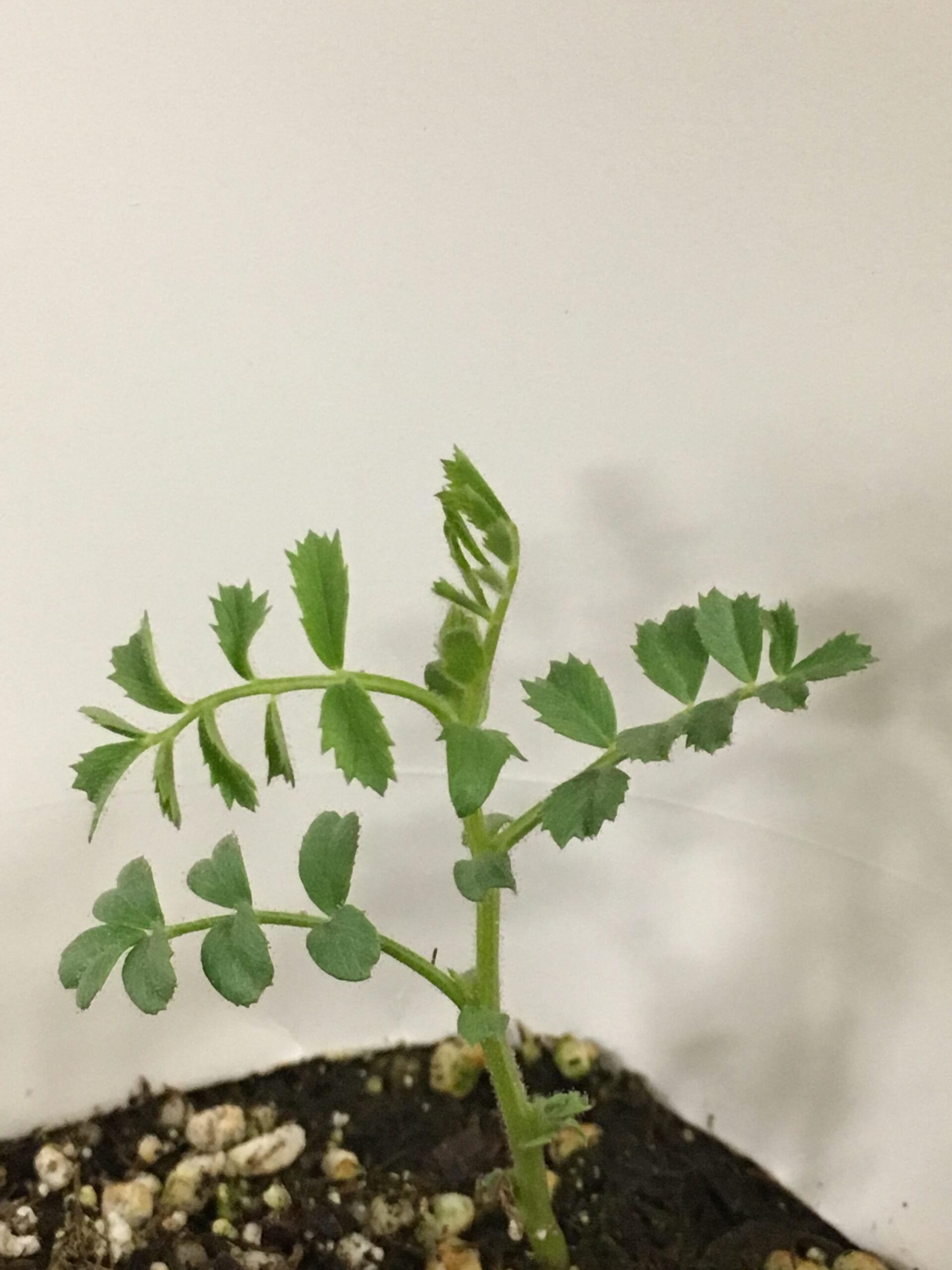
Staging Pulses for Herbicide Applications In-Crop
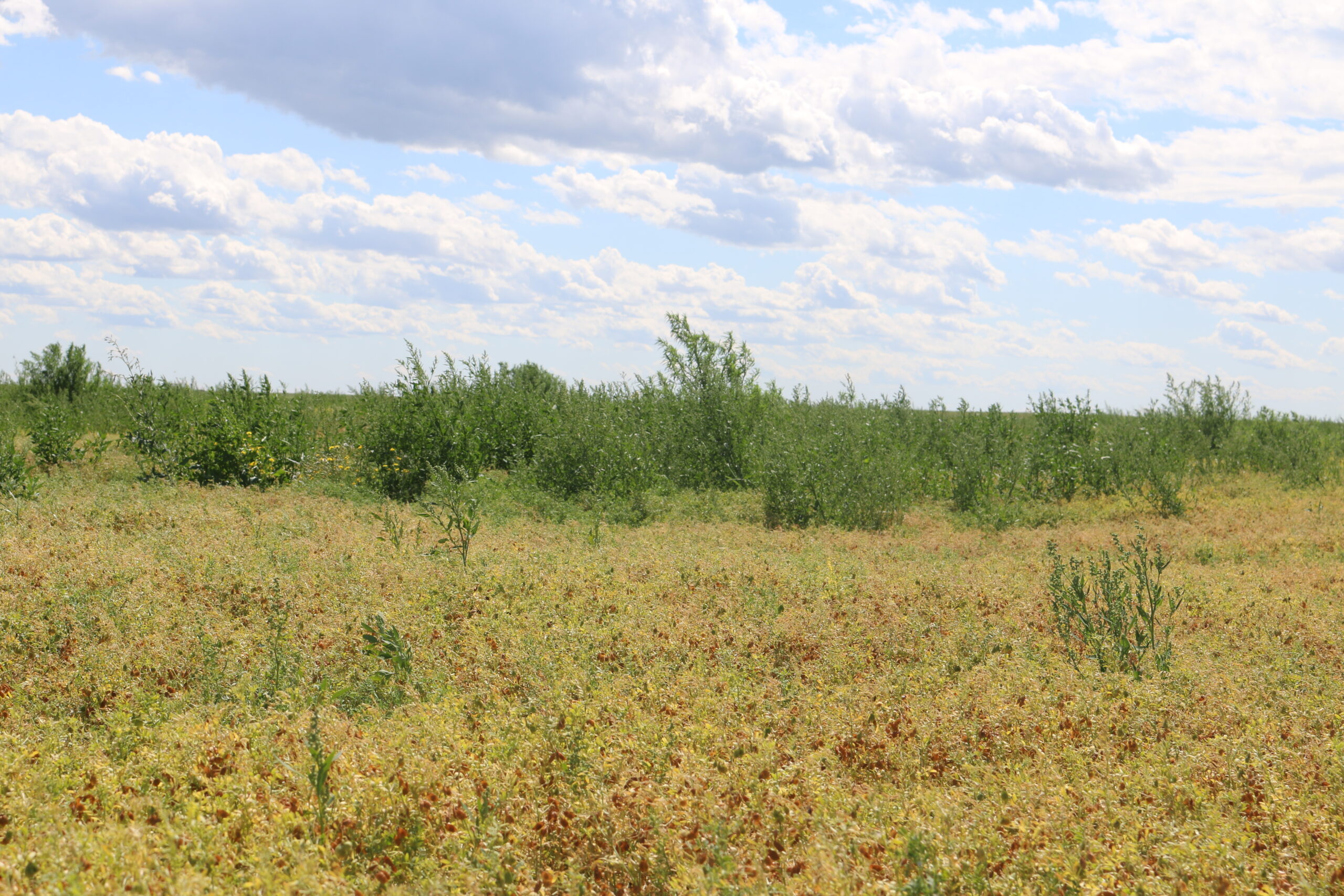
Critical Period of Weed Control in Pulses
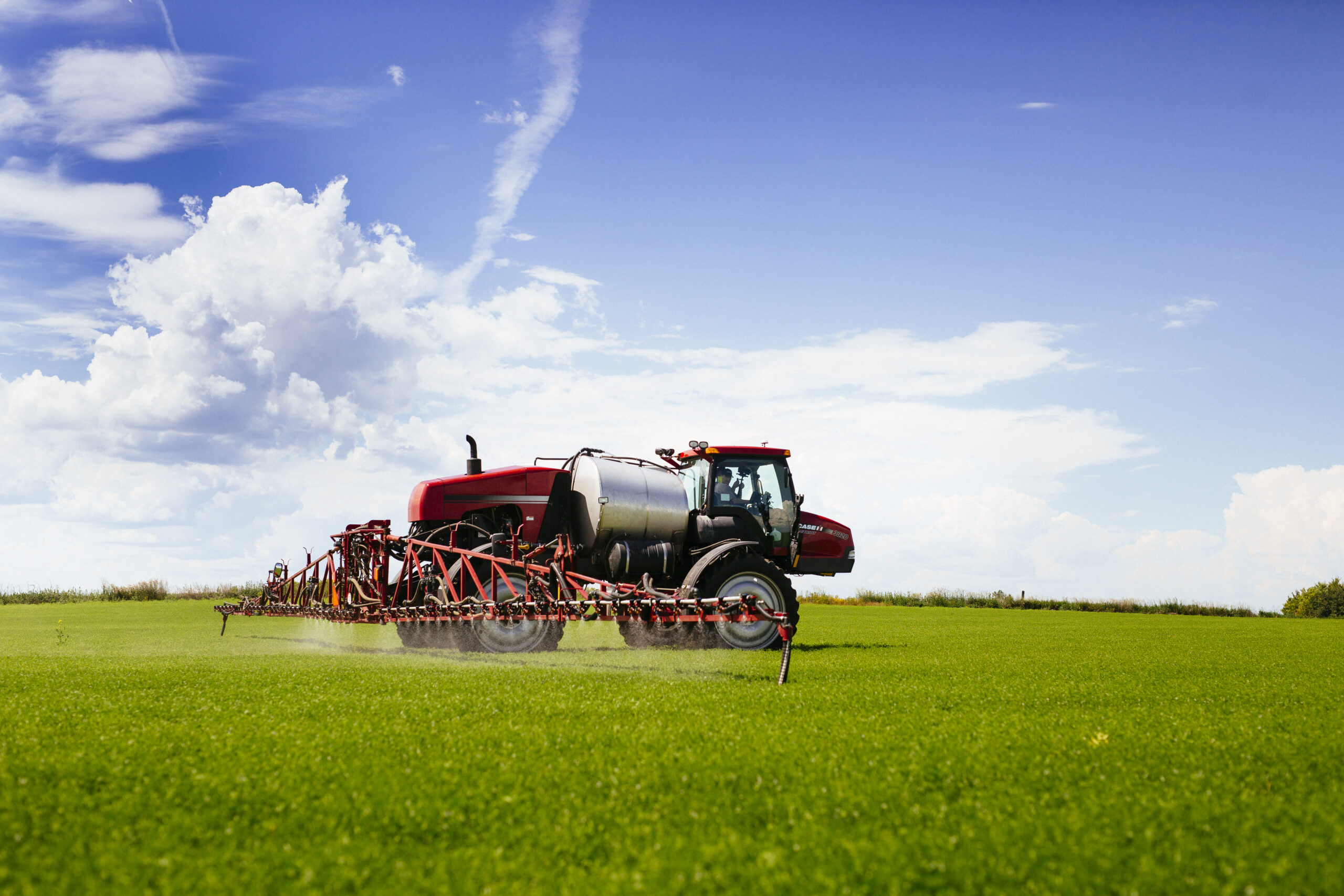
Post-Emergent Herbicide Options for Faba Beans
Disease Management
Faba beans are subject to several diseases that can reduce yield and quality. While some faba bean diseases are widespread in Saskatchewan, they may cause little damage. However, other faba bean diseases found in Saskatchewan can be very damaging and warrant appropriate control. Seed, soil, and plant residues can serve as sources of disease inoculum. These risks may be minimized by:
- Implementing effective crop rotations. Plant faba beans in the same field only once in four years. Continuous production of broadleaf crops can increase some seedling diseases and sclerotinia stem rot. Crop rotations that include cereal and oilseed crops can reduce the build-up of soil-borne pathogens specific to faba beans. However, rotations with cereals will not decrease fusarium root rot, as cereals are also hosts of this pathogen.
- Using the best seed available. A seed test will indicate the presence of seed-borne diseases.
- Use a registered fungicide seed treatment, especially if seeding into cool, wet soils.
- Seeding early.
- Monitoring of fields for diseases.
Disease Diagnosis
High yield losses are possible if disease inoculum is present, and rainfall is forecast. Early identification of the infection is critical as it allows sufficient time for planning a fungicide application. Remember that tiny, microscopic organisms cause disease. By the time large-scale symptoms can be seen, it may be too late to act. Begin scouting for faba bean disease at the early leaf stage, and at least every seven days thereafter if conditions are conducive to disease development.
First scout areas that are at the greatest risk of disease development, including:
- Fields planted with infected seed.
- Fields that had the same pulse crop in the previous two years.
- Fields planted to the most disease-susceptible cultivars (varieties rated as having ‘poor’ or ‘very poor’ resistance to disease should be monitored carefully).
- Field margins adjacent to last year’s infected faba bean stubble.
- Areas where the plants have been stressed or have a dense plant canopy.
- Fields with high moisture. Increase scouting frequency if moist conditions prevail (foliar diseases thrive and spread during warm weather with frequent rain showers).
If time allows, scout additional parts of the field:
- In a field smaller than 100 acres, check a minimum of five sites. In a field greater than 100 acres, check a minimum of 10 sites.
- Walk an “M” pattern throughout the crop to cover a large area.
- Early symptoms are usually first noticed in the lower canopy. Look closely at the lower leaves and stems (a magnifying glass will help).
- Use flags to mark specific areas in the field for regular monitoring to watch for disease spread to new tissues and/or to determine the effectiveness of previous fungicide applications.
Confirm the disease you are trying to control. Chemical injury, weather damage, fertility problems, insect damage, or root rot can be mistaken for foliar diseases. The following disease descriptions will assist you in identifying the faba bean disease in your field.
These are soil-borne diseases caused by species of Rhizoctonia, Pythium, Fusarium, and Botrytis. These pathogens are present in all Saskatchewan soils and can infect and kill individual seedlings from germination to the early flowering stage.
Symptoms may include poor emergence, root decay, root lesions, stunting, yellowing, and death of shoots. Lesions may develop on the stem base leading to constriction of the stem and seedling collapse. Usually, only scattered plants are infected, so these diseases rarely cause economic loss. With seedling blight, the base of the stem becomes pinched, and the seedling turns yellow and dies.
Follow a crop rotation that does not include faba beans or other pulses more than once in four years which will reduce the build-up of soil-borne pathogens. However, many of these pathogens can survive as saprophytes in the absence of a susceptible host, therefore crop rotation may have a limited effect in managing seedling blight and root rot.
Seedling stress or damage due to environmental or herbicide injury can lead to an increase in the incidence of seedling blight.
A seed test can determine if faba bean seed is infected with a seed-borne disease, such as Anthracnose, Ascochyta, Botrytis, Sclerotinia, or Fusarium. Consider using a seed treatment: (1) if the disease is detected (2) if there is a history of soil-borne diseases or, (3) if seeding under cool moist soil conditions. If a seed treatment fungicide is used, ensure compatibility with rhizobia inoculants.
Ascochyta blight is a seed-borne or residue-borne disease of faba beans in Western Canada. Ascochyta leaf and pod spot is caused by Ascochyta fabae. It is not the same Ascochyta species which infects other pulses and is specific to faba beans.
Leaves, stems, pods, and seeds can all be infected. Lesions appear as tan or grey spots with dark margins, and tiny black fruiting bodies (pycnidia) in the centre. Cool, rainy weather is conducive to the spread and infection of the disease and is most damaging to maturing pods and seeds if prolonged wet weather occurs during July and August. In severe infections, seeds developing in the pods become discoloured and shrivelled. Severely infected seed lots may not be marketable or will be downgraded severely due to discolouration.
Producers are advised to have their seed tested for seed-borne Ascochyta blight at an accredited seed test laboratory. Ascochyta blight inoculum also overwinters on faba bean residue, so producers should not plant faba bean on faba bean stubble.
If disease inoculum is present and weather conditions favour disease development, a fungicide should be applied to protect healthy plant material. Apply fungicide at the beginning of flowering or the onset of symptoms. Usually, one well-timed application is sufficient for controlling faba bean diseases.
Avoid consecutive sprays of the same fungicide group to avoid the development of fungicide resistance.
Anthracnose in faba beans is caused by Colletotrichum truncatum. This is the same species which causes Anthracnose in lentils and field peas.
Crop rotation is the key to preventing this disease as it allows time for faba bean residue to decompose and break the disease cycle. Allow three to four years between faba bean crops. Also, avoid growing faba beans after lentils or peas. Faba beans should not be planted adjacent to the previous year’s faba bean, lentil, or pea fields to reduce the spread of residue and wind-borne spores.
Plant seed that has zero or acceptable levels of seed-borne disease, as determined by an accredited lab. Use seed treatments to protect the seed and seedlings from seed-borne diseases.
Chocolate spot is caused by Botrytis fabae and Botrytis cinerea and can be residue-borne or seed-borne. Botrytis cinerea is the same species which infects lentils, causing grey mould on the stem and pod rot. Botrytis chocolate spot is a major disease of faba bean in other parts of the world. This disease often sets in later in the season with minimal impact on yields, however, early infections can result in yield loss.
First, small reddish dots appear which grow into well-defined blotches with reddish-brown margins and tan centres on the leaves, stems, and pods. If conditions are suitable, the lesions grow and merge, resulting in blackening and partial defoliation.
Avoid growing faba beans after lentils in areas where this disease is present. Follow a crop rotation of four years between successive crops of faba beans and avoid buckwheat or lentils in the rotation. However, Botrytis spp. can survive in the absence of a host crop, so crop rotations will not eliminate the disease. It is also important to use disease-free seed. Fungicides should be applied at early flower or before the onset of symptoms.
Sclerotinia stem rot is common in many broadleaf crops in Western Canada, but so far is less of a problem with faba beans. This disease may appear late in the season with minimal impact to yield.
Crop rotation is the key to preventing disease. Sclerotinia sclerotiorum will affect other host crops in the rotation so allow three to four years between faba beans and other host crops. Faba beans should follow a cereal crop in the rotation, rather than an oilseed or pulse crop. Research-based on soybeans found that no-till may result in fewer white mould fruiting bodies as compared to minimum tillage.
Apply fungicides at early flower followed by a second application seven to 14 days later if the disease persists, or if weather conditions are favourable for disease development. Use higher registered rates (if applicable) to obtain extended protection and maximum yield benefit. Follow label directions specific to the product used.
Note that it is too late to control Sclerotinia white mould once symptoms are observed, so forecast to determine the risk of disease development.
Rust is caused by Uromyces fabae. Rust can be a highly destructive disease of faba bean in other countries but has rarely caused losses in Canada. The disease relies on high humidity and is spread by late-season irrigation.
Rust-coloured, blister-like pustules develop on the leaves and stems surrounded by chlorotic halos. Spores can survive on crop residue and seed so a crop rotation of at least two years between faba bean crops should be used. Currently, no products are registered for control.
This disease can be found in faba beans. Other pulse crops are susceptible to this virus, therefore, avoid planting faba beans near established fields of forage legumes.
Aster yellows is a common disease on faba beans in Western Canada, however, usually only one to 2% of the plants are infected and economic losses do not occur.
Initially, there is yellowing of the area between leaf veins. This is followed by progressive leaf death and dieback starting at the leaf margins. Additional symptoms include loss of lower leaves, stunting, and failure to flower. When infection occurs early in the season, the upper pods formed after the infection are small and do not set seed, while the lower stem is normal. Most infected plants die within several weeks after the onset of the first symptoms.
The disease is transmitted by an insect vector – potato leafhoppers. Leafhoppers arrive on winds from the southern United States as early as March. Although there are local leafhopper populations, infected leafhoppers from the United States are thought to be the primary source of infection. If economic thresholds are met, the disease can be controlled by controlling the leafhoppers.
Alternaria leaf spot is caused by Alternaria alternata, and Powdery mildew is caused by Microsphaera penicillata var. ludens. Fungicides are registered for the control of powdery mildew on faba beans.
Fungicide Resistant Disease Populations
Just as with different herbicide groups, fungicide groups also have the potential to develop resistance in the disease population. Any fungal pathogen population may contain some strains naturally insensitive to various fungicides. A gradual or total loss of disease control may occur if these fungicides are used repeatedly in the same fields. Other resistance mechanisms that are not linked to the site of action, but are specific for individual chemicals, such as enhanced metabolism, may also exist.
To delay fungicide resistance/insensitivity:
- Where possible, rotate fungicide groups.
- Where possible, tank mix fungicides that have a high risk of developing insensitivity with fungicides from a different group.
- Do not apply more than the maximum number of applications listed on the label.
- Avoid consecutive sprays of the same fungicide, or other fungicides in the same group, in a season.
- Fungicide use should be based on an integrated pest management (IPM) program that includes scouting and accurate record keeping of fungicide use and crop rotation.
- An IPM program also considers cultural, biological, and other chemical control.
- Monitor treated fungal populations for signs of fungicide insensitivity. If the disease continues to progress after treatment, do not reapply the same product at a higher rate.
- If you observe fungicide insensitivity, discontinue the use of the product and switch to a fungicide with a different mode of action.
Contact your local regional crops specialist or certified crop advisor for any additional pesticide management and/or IPM recommendations for specific crops and disease problems in your area.
Fungicides
Use foliar fungicide only when disease risk and potential loss are economically damaging. Applying fungicides for the wrong problem or at the wrong time will greatly reduce economic returns and can limit control options for later in the season if disease risk increases.
Resistance of several fungal pathogens to strobilurin fungicides (Group 11) has been reported in Saskatchewan. No more than two applications per year of any strobilurin fungicide should be made to the same field. The continuous use of strobilurin fungicides without fungicide rotation greatly increases the threat of disease resistance.
Related Resources
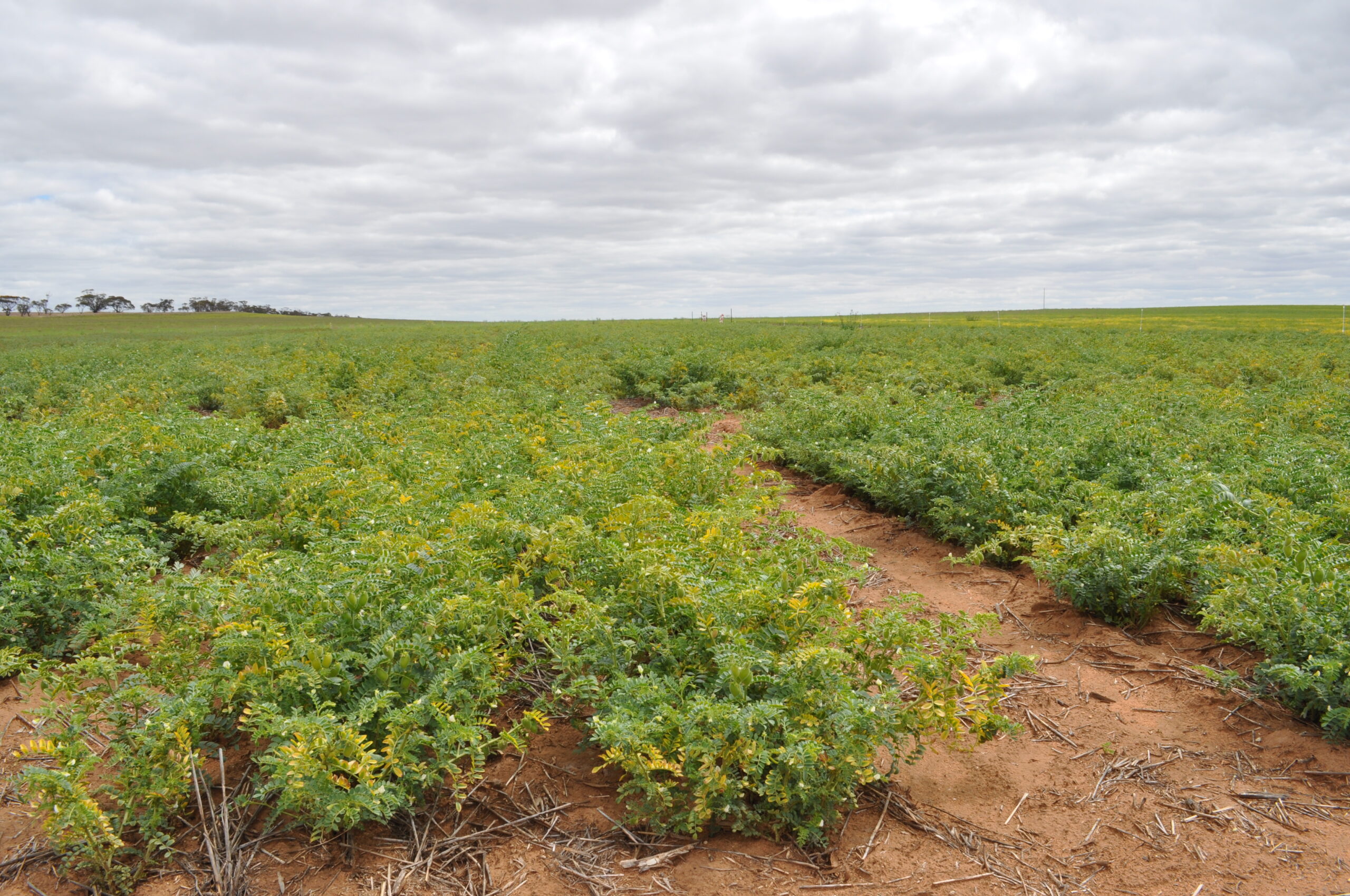
Viruses in Saskatchewan Pulse Crops
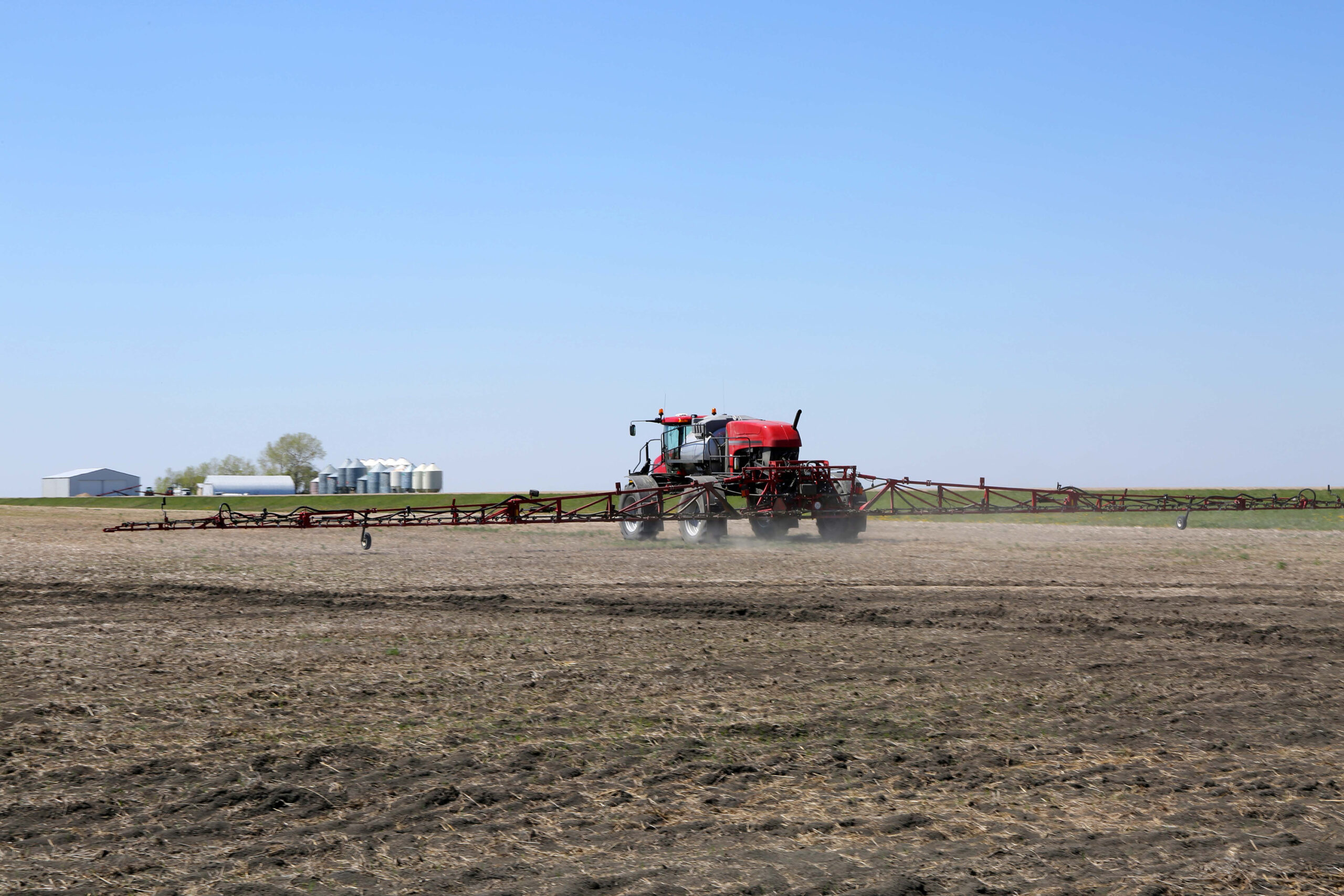
Faba Bean Fungicide Options

Diving into the Faba Bean Weed Research Program & Outcomes
Insect Management
There are several insects considered to be pests of faba beans: grasshoppers, lygus bugs, blister beetle, aphids, and pea leaf weevil. Below is a description of these insect pests and control methods.
Grasshoppers can be a major pest of faba beans. There are more than 80 species of grasshoppers on the prairies but only three species threaten faba beans. These three pest grasshoppers generally favour faba bean foliage and will feed on faba beans even when other food sources are available.
The three species of grasshopper that threaten faba beans are Melanoplus bivittatus (Two-striped grasshopper), Melanoplus packardii (Packard grasshopper), and Melanoplus sanguinipes (Migratory grasshopper). They are all spur-throated and have a spine below the head. The first adult grasshoppers that appear on the prairies by late May are not typically pests.
No economic thresholds have been established for faba beans.
If grasshopper control is required based on numbers sufficient to cause economic damage, the optimal insecticide timing is when nymphs are at the third instar stage, which is usually about mid-June. In the vegetative stage of the crop, it is the defoliation by grasshoppers that is a concern. As the plants develop to reproductive stages, the buds and pods can be affected by grasshoppers and infestations can affect pod formation, seed development, and ultimately yield.
It is critical to apply only insecticides registered for use in faba beans and to respect the pre-harvest interval of the insecticide selected to maintain crop marketability. All grasshoppers are susceptible to pyrethroids, certain organophosphate insecticides, and carbamate insecticides.
Lygus bugs can cause quality loss in faba beans, as they will move into the crop after other crops have matured and feed by using their sucking mouth parts to make pin holes in the seed coat.
Lygus bug infestations have posed a significant threat to profitable faba bean production in Alberta, due to the extensive acres of canola. As canola is harvested first, the lygus bugs move into the still green faba bean fields and damage seeds in the developing pods. Human consumption of faba beans has a very low tolerance for lygus bug damage (less than 1% for Grade No.1).
Three species of caragana or blister beetle will attack faba beans. Blister beetles often attack faba beans in swarms, but generally in small patches within the field. They usually do not feed for very long before moving elsewhere. Therefore, control measures are difficult to employ and there are no established action thresholds for faba beans.
(Potato leafhoppers) are the vector insect for aster yellows of faba beans but are also a sucking insect. Aster yellows are rarely yield-limiting in faba beans. Faba bean damage from leafhoppers can consist of distorted growth and plant stunting. Populations mainly blow in from the southern United States, but there are also small native overwintering populations.
The pea aphid adult is small, about 4 millimetres (0.15 inches) long, light green, and long-legged. The insect may be wingless or have prominent, translucent wings. Although pea aphids rarely survive winter in Saskatchewan, they may overwinter as an egg attached to the stems or leaves of alfalfa or clover. The eggs hatch in early spring and the young aphids feed on the newly emerged alfalfa or clover plants. During May and June, a new generation develops wings and with the aid of wind currents, flies to faba bean fields. Most aphids in faba bean fields are blown in on warm southerly winds from the United States in June or early July. The pea aphid weakens the plant by sucking its sap and is responsible for transmitting viral diseases.
Pea leaf weevil (Sitona lineatus) is a new and major threat in peas and faba beans. The main concern is larvae feeding on the nitrogen-fixing nodules. Feeding results in characteristic leaf notches but fortunately pea and faba bean seedlings can tolerate leaf notching and will usually recover unless there is very heavy feeding pressure.
The proportion of seedlings with terminal leaf damage (ex. leaf notches) provides an adequate indication of overall plant damage, and to some extent, potential yield losses. It is therefore recommended to inspect the average feeding damage on the terminal first leaf in 10 seedlings, five along the perimeter of the field, and five within the field. The action threshold for control is 30% damaged seedlings.
In the spring pea leaf weevil adults fly to legume fields where females lay eggs near the base of the host plant. The larvae feed on Rhizobium nodules. At maturity, larvae pupate in the soil and adults emerge to feed on leaves until late summer. Adults overwinter in field margins or alfalfa. Fortunately, there is no evidence of Sitona lineatus overwintering in stored grain. Pea leaf weevils are spreading outwards from the southwest corner of Saskatchewan and are a pest to watch for.
Where yield loss occurs, is primarily a result of the larvae feeding on the Rhizobium nodules reducing nitrogen to the crop. Seed treatments are the only available control for larvae feeding in faba beans. Control products currently registered for pea leaf weevil control in faba beans include seed treatments from the insecticidal group neonicotinoids.
Cutworms and wireworms can attack a wide variety of crop species and may attack faba beans. However, faba beans are very resilient, as they have growing points near the seed that enables the plant to regrow following below-ground insect feeding on the emerged or emerging seedling. Under high-risk situations, or where insect pressure is severe, there are insecticides registered for use in faba beans.
